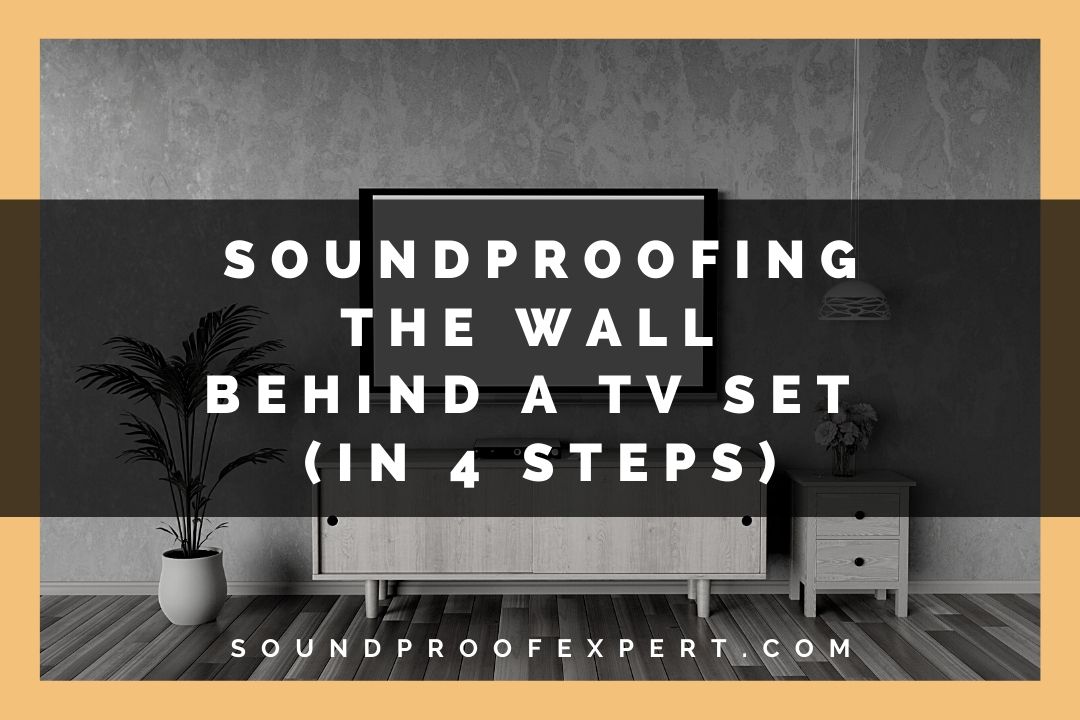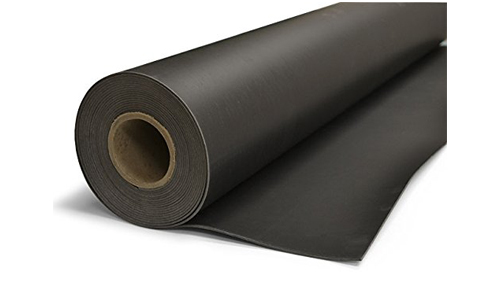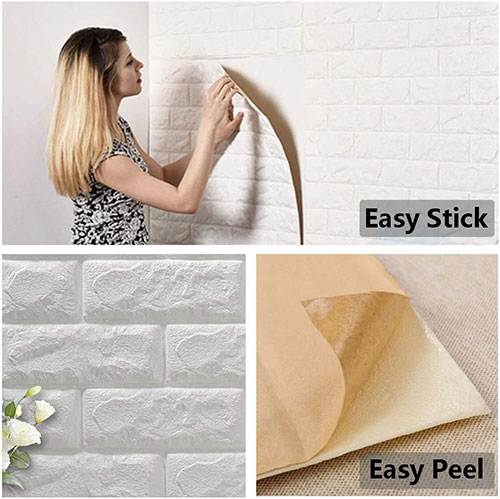
Do you love watching late-night TV but are worried that you might be bothering your neighbors or family members? Are you bothered by their loud TV? Don’t worry: you don’t have to mute the volume, nor do you have to wear earplugs — you can simply soundproof your wall instead.
If you need to soundproof a wall behind a TV, you need to first apply soundproof wallpaper or acoustic paint on the wall. Follow up with acoustic foam spray, then install acoustic foam tiles, a sound-barrier blanket, or mass-loaded vinyl (MLV). Finally, add an acoustic room divider.
These steps are relatively simple, but if you don’t do them right, they won’t be very useful. Therefore, make sure to keep reading to get all the details. Additionally, toward the end of this guide, you will find some extra tips on DIY cheap soundproofing methods that use everyday household items.
Get Soundproof Wallpaper/Paint and Other Materials
Before we get on with the guide, there are a few essential materials you might need to soundproof your TV wall. Make sure you have some of the following:- Soundproof wallpaper, such as Arthome WALL DECOR White Brick 3D Peel and Stick Wallpaper
- Hy-Tech Thermal Solutions Acousti-Coat Sound-Deadening Paint or another good quality acoustic paint
- Acoustic foam spray such as Ultimate Acoustics UA-AS1 Acoustic Adhesive Spray
- Gorilla Tough & Clear Mounting Tape or another heavy-duty double-sided tape
- Mass-loaded vinyl, such as Noise Grabber Mass-Loaded Vinyl
- Sound-barrier blankets like this Sound Barrier and Absorption Sheet
- Acoustic foam panels, such as burdburry Sound-Absorbing Panels
- An acoustic room divider, such as ReFocus Acoustic Room Divider or VERSARE Versifold Acoustical Room Divider
Apply Soundproof Wallpaper or Acoustic Paint on the Wall
If all you need is to soundproof the area directly behind your TV set, chances are you don’t want to dismantle the wall or soundproof the entire room. Instead, we’ve come up with a quick-fix solution that does not take up much of your time, money, and resources. The easiest way to go about it is by applying soundproof wallpaper or acoustic paint over your existing wall surface. Soundproof wallpaper is applied much like regular wallpaper, and nowadays, you can find many easy-peel products on the market.
Acoustic paint is somewhat messier to work with. Still, it could be even more effective than wallpaper as you can apply multiple layers. For best results, you want to apply at least three coats of paint. This will require a certain amount of patience as acoustic paint dries much slower than regular paint. It could take more than 32 hours before it is completely dry and ready for the next coat.
In addition to their sound-blocking qualities, soundproof wallpaper and acoustic paint can boost the room’s thermal insulation if applied on all four walls. Another added benefit is that they come in a wide variety of patterns and color schemes. Therefore, you can use the leftover wallpaper or paint to completely redecorate the whole room and even the rest of your home.
Apply Acoustic Foam Spray
You may find that soundproof paper or acoustic paint is all you need if you or the people on the other side of the wall don’t watch TV with the volume on full blast. However, if you want to take your soundproofing up a notch, consider adding soundproofing panels.
To prep the wall surface, you need to apply acoustic foam spray. This product serves as a powerful adhesive agent and also helps boost the soundproofing. Just make sure to spread newspapers or rags on the floor below the wall to protect the area from stray drops and leaks. You might also have to clean the wall surface if it’s dirty or dusty; otherwise, the spray might not stick.
Install Acoustic Foam Tiles, Sound-Barrier Blanket, or Mass-Loaded Vinyl (MLV)
The next step is to install acoustic foam tiles, a sound-barrier blanket, or MLV. Which product would be best for you depends on what you seek to achieve with regards to soundproofing. Acoustic foam tiles, like any other soft and porous material, do not block sound. However, acoustic foam is excellent at absorbing sound waves. That helps minimize echoing and reverberation and makes human voices more intelligible. For this reason, the acoustic foam could work great around a TV set.
Sound-barrier blankets have both sound-blocking and sound-absorbing properties. While they are not a particularly elegant choice in terms of interior design, they are easy to hang using strong double-sided tape. Later, you can quickly take them off with minimal fuss and damage to your wall. When it comes to heavy-duty sound-blocking, mass-loaded vinyl is your best choice. It also has a much sleeker look than both acoustic foam and sound-barrier blankets. However, MLV could be a little pricey.
Place an Acoustic Room Divider Between the TV Set and the Wall
Acoustic room dividers are specially developed to help dampen and muffle noises in offices and other busy environments. These free-standing panels are a great option if you don’t want to tamper with the wall, and there is enough room behind the TV to place the divider. Alternatively, acoustic room dividers can also complement any other soundproofing materials you may be using.
For best results, you may need to place a few panels one next to the other in a semi-circle behind the TV.
DIY Tips on How to Soundproof a Wall Behind a TV for Free
The steps above might not work for you if you are on a tighter budget or live in a rented property where repairs and renovations are not allowed. However, that does not mean you are out of options. There are a couple of alternative solutions you could try to soundproof the wall behind the TV. While they are not as effective as professional sound-insulating and sound-absorbing products, they are better than nothing and might help.
Rearrange the Furniture
The first thing you could try is to arrange your existing furniture. If possible, move large and heavy furniture such as bookcases or chests of drawers next to the wall you want to soundproof. The dense mass will successfully block some of the unwanted sounds. If it is your TV noise you are trying to soundproof, you can place or mount the TV set on one of these pieces of furniture.Use Soft Furnishings
Soft furnishings work much like acoustic foam panels. They are soft and porous and do not block sound, but they can be quite effective at absorbing it. That could help muffle unpleasant noises and higher frequencies. So, gather as many soft furnishings as you can — carpets, rugs, pillows, cushions, heavy curtains, tapestries, upholstered chairs — and place them around the TV set, on the wall behind the TV, and all over the room. You can use these also to redecorate the room and freshen up your interior. <2>Final ThoughtsLate-night binge-watching is everyone’s guilty pleasure. Who hasn’t pulled an all-nighter to catch up on the latest season of their favorite TV show? However, that should not come at the expense of your or your neighbors’ sleep. Some steps you could take to soundproof a wall behind a TV include:
- Applying soundproof wallpaper or acoustic paint on the wall
- Following up with acoustic foam spray
- Installing acoustic foam tiles, a sound-barrier blanket, or mass-loaded vinyl
- Placing an acoustic room divider
However, bear in mind that while these methods are effective, nothing can beat soundproofing unfinished walls during the construction phase.




I can’t hear my new smart tv. The wall behind the tv has a central a/c – heating unit on the other side. If I put a blanket or paint the wall will it help
Do you recommend a contractor in Ohio zip 44134. Our new home has wall mounted tv’s and TV noise is disturbing me in rooms adjoining.
I have a 65 inch tv that I want to hang on my fireplace wall. Unfortunately, it’s in the corner of the room and backs up to my bedroom wall…where my bed is located.
Can you give me some ideas. I was just going to buy the tiles but I have read your article so I am wondering if my idea will work
Thanks
Wendy Bragg